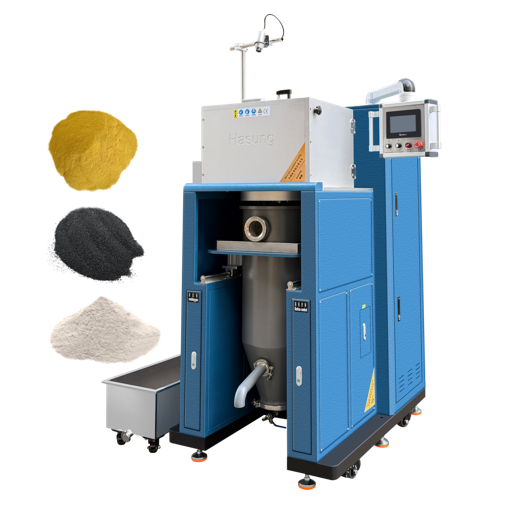In modern industrial manufacturing systems, metal powder serves as a critical raw material, widely utilized in powder metallurgy, 3D printing, electronics, and other industries. Its performance directly impacts the quality and production efficiency of downstream products. Metal powder water atomization equipment, with its unique technical advantages, has become a core tool for efficiently producing high-quality metal powder. This article delves into the key mechanisms behind its role in efficient preparation.
1. Fundamentals of Metal Powder Preparation and Water Atomization Technology
(1) The Value Anchors of Metal Powder Preparation
The particle size distribution, sphericity, purity, and other properties of metal powder are the “cornerstones” of downstream processing. In powder metallurgy, uniform and fine powder ensures consistent part density and superior strength. In 3D printing, high-quality powder is a prerequisite for the precise forming of complex and intricate components, determining the density and mechanical properties of printed parts.
(2) Principles of Water Atomization Technology and Equipment
Water atomization technology uses high-pressure water jets to impact and break up molten metal streams, which then solidify into powder. Metal powder water atomization equipment consists of melting, atomization, condensation collection, and control systems. The melting system liquefies raw metal materials into a stable flow, which is then guided through a conduit. The atomization system employs high-pressure water nozzles to fragment the molten stream. The condensation collection system rapidly cools the droplets into powder, while the control system precisely regulates parameters such as temperature, pressure, and flow rate.
2. Key Aspects of Efficient Preparation via Water Atomization Equipment
(1) Melting Control: Ensuring High-Quality “Raw Material”
1.Precise Temperature Control
Different metals/alloys have varying melting points and fluidity. For example, producing aluminum alloy powder requires stable temperature control to ensure proper melting and flow while avoiding oxidation and component loss. Advanced equipment relies on high-precision sensors and intelligent temperature regulation to provide a stable molten stream for atomization.
2.Material-Specific Design
The equipment must accommodate iron, copper, aluminum, specialty alloys, and rare metals. The melting chamber structure and materials are tailored to the raw material properties (density, thermal conductivity, oxidation tendency). For instance, when melting titanium alloys, inert gas protection is applied to prevent oxidation and maintain powder purity, expanding the equipment’s applicability.
(2) Atomization Process: The Core of Efficient Fragmentation
1.Atomization System Optimization
Nozzle Design and Layout: The nozzle is the core component, where its structure (aperture, angle, flow channel) and arrangement affect fragmentation efficiency. Annular or multi-nozzle configurations impact the molten stream from multiple directions, improving atomization efficiency and powder sphericity. Nozzle materials must be wear- and corrosion-resistant to ensure long-term stability and minimize efficiency loss.
Pressure and Flow Regulation: Based on the raw material and target particle size, high-pressure water parameters are precisely adjusted. Fine powders require higher pressure and flow rates, while coarser powders need moderate reductions. An intelligent control system uses sensor feedback to automatically adjust pump speed or valve openings, ensuring stable atomization and achieving the desired particle size distribution.
2.Atomization Environment Control
Clean and Stable Water Flow: Atomization water must be purified, with filtration, de-oiling, and softening systems to remove impurities. High-pressure pumps stabilize water pressure to prevent fluctuations that could lead to uneven particle size and poor sphericity.
Chamber Pressure and Atmosphere: Controlling chamber pressure promotes rapid droplet cooling and refines particle size. For reactive metals (e.g., magnesium, titanium), inert gas is introduced to prevent oxidation, ensuring powder purity and laying the foundation for product quality.
(3) Condensation Collection and Post-Processing: Synergistic Efficiency Boosters
1.Rapid Condensation for Performance Preservation
Optimizing the condensation chamber structure—increasing cooling surface area and enhancing heat exchange—ensures rapid droplet solidification, reducing issues like particle growth and irregular shapes. For example, a spiral-channel condensation chamber extends droplet contact with the cooling medium, ensuring sphericity and uniform particle size for high-end manufacturing.
2.Seamless Collection and Post-Processing Integration
Efficient Collection: A conical collection chamber with vibration-assisted powder discharge ensures smooth operation and continuous production.
Integrated Post-Processing: The equipment connects with sieving, impurity removal, and drying units, transferring wet powder for drying and grading. The control system coordinates all stages, adjusting parameters based on powder characteristics to achieve integrated preparation and post-processing, reducing intermediate delays and manual intervention while boosting productivity.
3. Practical Applications and Optimization Directions
(1) Case Study
A high-end alloy manufacturer used advanced water atomization equipment to produce superalloy powder. Precise melting temperature control and optimized atomization parameters yielded powder with a particle size of 10–150 μm and high sphericity, meeting aerospace 3D printing requirements. The equipment operated stably, increasing unit output by 30% and raising yield from 75% to 90%, driving enterprise upgrades.
(2) Optimization Explorations
1.Intelligent Upgrades
Incorporating AI and big data enables self-learning and adaptive adjustments. Production data is collected to build smart models that automatically optimize process parameters (temperature, pressure, flow rate) based on raw materials and target properties, supporting customized production and reducing manual tuning costs.
2.Energy Efficiency and Environmental Improvements
Replacing resistance heating with electromagnetic induction improves melting efficiency. Optimizing water circulation systems recycles resources, reducing consumption and emissions. Research into eco-friendly cooling media minimizes environmental impact, promoting sustainable industry development.
4. Conclusion
Metal powder water atomization equipment, through precision design and optimization of melting, atomization, and condensation collection processes, serves as a key enabler of efficient preparation. From theory to practice, continuous innovation has significantly improved powder quality, efficiency, and sustainability. In the future, with advancements in intelligence and green technology, such equipment will propel the industry toward greater efficiency, quality, and sustainability, strengthening the raw material foundation for modern manufacturing and empowering downstream industrial innovation.
This English translation maintains the technical accuracy and structure of the original Chinese article while ensuring clarity and readability for an international audience. Let me know if you’d like any refinements!
Post time: Aug-07-2025












